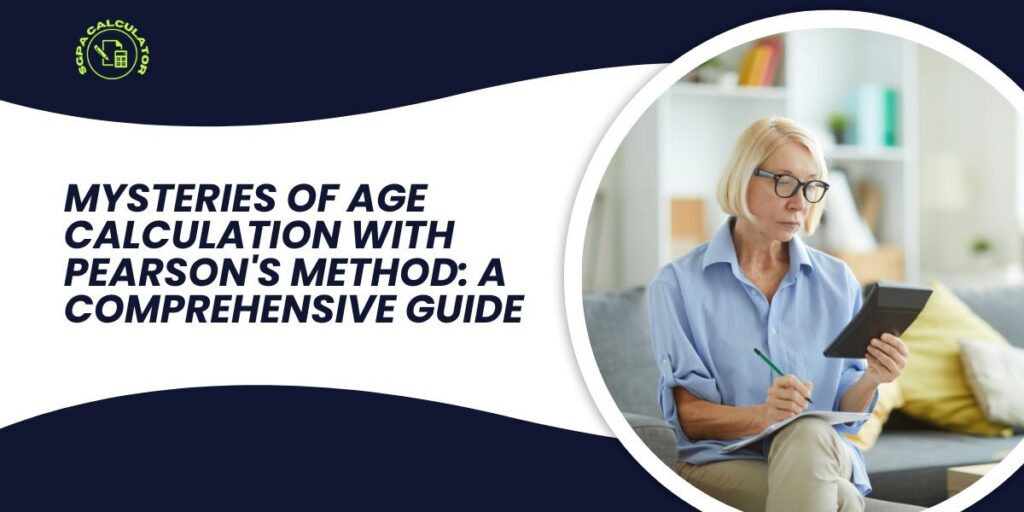Age calculation has always been a topic of fascination and necessity in various fields, ranging from demographics and psychology to healthcare and education. Understanding someone’s age accurately can provide crucial insights into their development, behavior, and overall well-being. While there are numerous methods and formulas to calculate age, one approach stands out for its simplicity and accuracy: Pearson’s Age Calculator. In this comprehensive guide, we delve into the intricacies of Pearson’s method, exploring its history, principles, and practical applications.
Understanding Pearson’s Age Calculator
Introduction to Pearson’s Method
Age Calculator, named after its creator Karl Pearson, is a statistical technique used to estimate an individual’s age based on certain physical or physiological measurements. The method relies on the principle of correlation between age and the chosen variables, such as height, weight, bone density, or cognitive abilities. By analyzing these variables in relation to age within a sample population, Pearson developed formulas to predict age accurately.
Science Behind Pearson’s Method
Pearson’s method is grounded in the concept of biological aging, which encompasses the progressive changes that occur in the human body over time. These changes manifest in various aspects, including skeletal growth, organ function, and cognitive development. By identifying the key markers of aging and their correlation with chronological age, Pearson devised mathematical models to quantify this relationship.
Principles of Age Estimation
The core principles of Pearson’s Age Calculator revolve around statistical analysis and regression modeling. The process involves collecting data from a diverse sample population, measuring the relevant variables, and establishing a correlation with chronological age. Through regression analysis, Pearson derived equations that express age as a function of the selected variables, allowing for precise age estimation based on observed measurements.
Practical Applications of Pearson’s Age Calculator
Forensic Science
One of the most prominent applications of Pearson’s method is in forensic science, particularly in estimating the age of unidentified human remains. Forensic anthropologists use skeletal measurements and dental characteristics to assess the age of skeletal remains, aiding in criminal investigations and the identification of missing persons.
Read Our Blog: Chronological Age Calculator
Pediatric Medicine
In pediatric medicine, Pearson’s Age Calculator finds utility in assessing children’s growth and development. Pediatricians rely on growth charts and milestone achievements to monitor a child’s progress relative to their age cohort. By incorporating Pearson’s method, healthcare providers can refine age estimates for children with atypical growth patterns or developmental delays.
Gerontology and Age-related Research
Gerontologists and researchers studying aging processes leverage Pearson’s Age Calculator to investigate age-related phenomena and develop interventions for age-related conditions. By accurately estimating individuals’ ages within study cohorts, researchers can analyze trends, identify risk factors, and evaluate the effectiveness of interventions aimed at promoting healthy aging.
Implementing Pearson’s Age Calculator: A Step-by-Step Guide
Data Collection
Begin by gathering a representative sample of individuals spanning a wide age range. Collect relevant data, such as height, weight, bone density, cognitive test scores, or any other variables of interest.
Statistical Analysis
Perform statistical analysis to identify correlations between the selected variables and chronological age. Utilize techniques such as linear regression or multivariate analysis to establish predictive models.
Model Validation
Validate the predictive models using independent datasets to assess their accuracy and reliability. Adjust the models as needed to improve predictive performance and generalizability.
Application and Interpretation
Apply the validated models to estimate individuals’ ages based on their measured variables. Interpret the results in the context of the specific population and purpose of age estimation.
Conclusion
Pearson’s Age Calculator offers a valuable tool for age estimation across various disciplines, from forensic science and medicine to research and beyond. By harnessing the power of statistical analysis and regression modeling, this method provides accurate insights into individuals’ ages based on measurable attributes. Whether unraveling the mysteries of skeletal remains or tracking children’s developmental milestones, Pearson’s method continues to shape our understanding of age and human development. As technology advances and datasets expand, the applications of Pearson’s Age Calculator are poised to grow, contributing to advancements in diverse fields and enriching our knowledge of the aging process.





